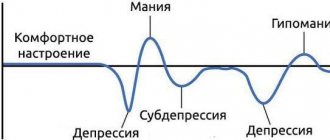Dissocial personality disorder (sociopathy) is a disregard for social norms and rules, lack of attachment, aggression and a tendency to commit illegal actions. A sociopath is impulsive and aggressive, devoid of sympathy and affection, and therefore does not experience pangs of conscience when he harms others. However, with treatment from a psychotherapist, it is possible to improve the behavior of a person with a dissocial disorder, which makes life easier not only for those around him, but also for himself.
Dissocial personality disorder is not a disease, but a personality trait. A psychotherapist will help smooth out manifestations of character and make life easier in society.
This condition is also referred to as sociopathy, antisocial personality disorder, antisocial psychopathy.
As in psychotic states, such a person is driven by impulses. However, unlike illegal behavior in psychosis, sociopaths understand that they are violating the norms and rules of society.
The exact cause of the disorder is unknown, but genetic factors (heredity, random genetic mutations) and upbringing play a major role.
Treatment tactics
This process should be carried out by a specialist experienced in treating this disorder.
Its task is to develop a set of measures that would alleviate the symptoms of the disease, improve the patient’s well-being, restore the integrity of the patient’s psyche, and consolidate a single identity. At the same time, it is important that nothing harms the person
There are no medications that can cure dissociative identity disorder, but it is quite possible to eliminate individual symptoms with their help. So, antidepressants and tranquilizers will help relieve depression, excessive activity or anxiety. But you should be extremely careful with pharmaceuticals - people with this disorder become addicted to such medications very quickly.
The main method of treatment is psychotherapy:
- insight-oriented;
- family;
- group;
- cognitive;
- rational;
- hypnosis.
Any type of psychotherapy has the task of changing the patient’s beliefs, stereotypes and inappropriate thinking. Specialists in the field of behavioral psychology act as trainers of the patient’s consciousness, trying to reproduce all possible traumatic situations and teach the patient to react correctly to them.
Hypnosis makes it possible to bring existing multiple personalities into one and get rid of depressing memories. Such work must be very delicate, like jewelry, since the slightest mistake can seriously harm.
Insight-oriented psychodynamic therapy is the work of a specialist with all the personalities of the patient. The psychiatrist accepts each of them, treats everyone with equal respect and gives no preference to anyone. This process usually lasts more than one year.
It is impossible to completely cure dissociative multiple identity disorder, so it is considered chronic and very severe. The whole point is that each person, in turn, can suffer from his own mental disorder, including dissociative one.
Patients with dissociative flight (fugue) have much better prospects - recovery occurs quite quickly, as in the case of dissociative amnesia. However, the latter can become chronic and then the prognosis is not so rosy.
Symptoms
This mental disorder is manifested by the following symptoms:
- The dissociative flight reaction is a dissociative fugue. The person behaves quite normally, but acquires character traits that are unusual for him and moves away from his place of residence. Unconscious memory loss (partial or complete) occurs. A person may suddenly leave work, behave differently than usual, respond to different names and not understand what is happening. This abnormal condition passes quickly, and the return to normal is rapid.
- Dissociative amnesia - under the influence of stress or a traumatic event, the memory suddenly disappears, but the individual understands this. His consciousness “works” normally and he is able to perceive any new information.
- Dissociative identity disorder. A personality is split into several, each having its own name, character, thinking, psychological properties, behavior, and nationality. Each of them periodically “commands” a person, personalities change each other without any reason or systematicity. The individual does not realize or feel such replacements, does not remember what happened to him in one form or another.
- Depersonalization disorder - a person seems to observe his body and mental processes in it from the outside. The surrounding world seems colorless, unreal (derealization), and parts of the body are of incomprehensible sizes, the sense of time is lost. The individual feels like he is a robot and is tormented by anxiety and depression.
- Derealization without depersonalization.
- Trance is a violation of consciousness, there is no reaction to external stimuli. This is how children react to trauma or violence. Common to trans mediums during a seance and to pilots during a long flight. It is also observed in a number of cultures, such as excitement and rage, memory lapses, and strange actions, for example, among the Malays and Eskimos (Amok, Piblokto).
- Ganser syndrome - deliberately incorrect answers to the simplest questions (faint speech), simulation of a severe mental illness. Sometimes accompanied by amnesia, loss of orientation, and perception disorders. Common among male prisoners.
If you notice such signs in yourself or in your relatives, you should contact a psychiatrist or psychologist. Treatment must be carried out in a timely manner, as complications are possible:
- prolonged depression;
- suicide attempts;
- severe headaches;
- self-harm;
- problems with eating;
- sexual dysfunction;
- anxiety disorders;
- drug addiction or alcoholism;
- nightmares, sleepwalking, insomnia.
Dissociative movement disorders, sensory disorders
These disorders appear as a physical illness, but there are no physical causes
Therefore, when diagnosing these disorders, care must be taken not to neglect physical illnesses. A thorough mental status examination should be performed
Dissociative motor skills disorders manifest as severe agitation or weakness or even immobility, and polio is very common. Usually this is paralysis of one limb.
Physical symptoms vary depending on the person's current mental state. The above symptoms may serve as a sort of maneuver by which he or she joins the person he or she does not want to lose. It can also manifest itself with a strong desire to avoid painful conflict. Milder forms of movement disorders are relatively common in adolescent girls. Vision, hearing and loss of smell are less common
It is important to rule out neurological diseases such as multiple sclerosis
Examples of behavior from life
In life, it can look like this: an adult suddenly begins to speak and behave like a child, the manner of speaking and judgments change. Another example: a person may not understand where he is, who surrounds him, or finds new things in his home environment, the appearance of which he cannot explain.
In the worst case, a person can commit a crime (kill, rob, cause bodily harm) during the period of activity of one of the individuals, and then not understand what happened and deny his involvement.
Film "Glass" (Glass, 2019)
There is a well-known example from life when two personalities within one person competed for the love of a girl. If one person wants the death of another, everything can end in suicide if you do not intervene in time.
What provokes / Causes of Dissociative (conversion) disorders:
Biological, psychological and social factors play a role in the origin of disorders:
biological factors include the meaning of heredity and constitutional characteristics of the individual. Past illnesses are important, most often disorders occur during periods of crisis, prepubertal and pubertal age, as well as during menopause;
Psychological factors include demonstrative traits in the premorbid period, mental trauma and deprivation suffered in childhood, increased suggestibility and sexual disharmony of the married couple. In addition, the psychology of dissociative disorders includes the mechanism of conditioned pleasantness and desirability of the symptom - the person receives some kind of gain due to his illness. Thus, the symptom contributes, for example, to keeping the object of love nearby;
Social factors include dissociated upbringing, including the contradictory demands of the mother and father for the child, as well as the individual’s desire for a rental attitude.
Clinical picture
Usually in such situations, all pronounced symptoms are in full agreement with how the patient imagines the process of the disease. Medical diagnostics, as a rule, do not give a clear answer about the presence of any neurological diseases or physical disorders.
In such situations, it becomes obvious that the loss of mental functions is a consequence of the unmet emotional needs of the patient or a serious mental conflict caused by the corresponding trauma. Often, the existing symptoms have a gradual development associated with the patient being in a stressful state for a long time, and are followed by a sudden manifestation, since the tension is cumulative.
This may include types of disturbances associated with physical condition and functions that are normally controlled in a healthy state, as well as dulling of sensitivity.
Pathogenesis (what happens?) during Dissociative (conversion) disorders:
The onset and end of dissociative states are often sudden, but they are rarely observed except in specially designed interactions or procedures such as hypnosis. The change or disappearance of the dissociative state may be limited by the duration of these procedures.
All types of dissociative disorders tend to remit after a few weeks or months, especially if their onset was associated with a traumatic life event. Sometimes more gradual and more chronic disorders can develop, especially paralysis and anesthesia, if the onset is associated with insoluble problems or disrupted interpersonal relationships. Dissociative states that persisted for 1-2 years before contacting a psychiatrist are often resistant to treatment.
Films about mental dissociation
Famous film about dissociation: “The Three Faces of Eve” (1957, directed by Nunnally Johnson), based on real events. Three personalities coexist within a woman; her husband and psychiatrist are trying to help her cope with the different “I”s within herself. The series “Sybil” (1976, Daniel Petrie) is also about a real woman who experienced sexual abuse as a child and throughout her life feels alternately like completely different people. You can also call Frankie and Alice (2009, Jeffrey Sachs), Psycho (1960, Alfred Hitchcock).
Classification
There are several types of classification of this disorder.
In most cases, a general division into forms is used:
- dissociative fugue;
- dissociative amnesia;
- organic dissociative disorder;
- dissociative movement disorders.
In some cases, a broader classification is used, which was proposed by American scientists:
- dissociative fugue;
- amnesia;
- dissociative movement disorders;
- organic dissociative disorder;
- dissociative stupor;
- convulsions;
- trance and obsession.
The general clinical picture will be supplemented by specific signs that are characteristic only of a specific form of a given psychiatric disorder.
Modern psychiatry
Now dissociative disorders are understood as a whole group of mental disorders, which includes the following pathological conditions:
- Psychogenic (dissociative) fugue is the loss of personal identity and the emergence of another. The phenomenon is quite rare. It is characteristic of persons with schizoid disorder.
- Psychogenic amnesia (some memories are inaccessible to consciousness). The most common form. With clear consciousness, memory suddenly disappears, and the person is aware of it. It recovers on its own after some time.
- Dissociative identity disorder is the most severe form. It can begin in childhood or adolescence, and appears most often in young people, especially women.
In this case, the manifestation of any form of the disease can suddenly stop. This usually happens if the impetus for a dissociative disorder was a traumatic situation.
According to ICD-10, this disease is divided into the following subtypes:
- fugue;
- convulsions;
- amnesia;
- stupor;
- loss of sensory perception;
- movement disorders;
- convulsions;
- obsession and trance.
To separate such conversion disorders from other mental pathologies, there is a special criterion - the presence of integrity in the patient between the following components:
- your feelings;
- memory of one's own history;
- ability to control one’s motor function;
- awareness of oneself as a person.
Such integrity may be broken partially or completely.
What are dissociative (conversion) disorders -
Dissociative (conversion) disorders (the old name is conversion hysteria) are disorders that are expressed in partial or complete loss of conscious control over memory and sensations, on the one hand, and over control of body movements, on the other. There is usually a considerable degree of conscious control over the memories and sensations that can be selected for immediate attention, and over the movements that must be performed. In dissociative disorders, this conscious and selective control is thought to be impaired to such an extent that it may vary from day to day and even from hour to hour. The extent of loss of function under conscious control is usually difficult to assess.
The term "conversion" is widely used for some of these disorders and implies an unpleasant affect generated by problems and conflicts that the individual cannot resolve and translated into symptoms. Patients with dissociative disorders typically deny problems and difficulties that are obvious to others. Any problems that are recognized by them are attributed by patients to dissociative symptoms.
The disorders are characterized by a close temporal relationship with traumatic events, unresolved and intolerable events, or broken relationships. An increase in the number of disorders is typical during periods of wars and conflicts or natural disasters. They are more common in women than in men and in adolescence and adolescence than in middle age.
Among the dissociative disorders, the following main types are distinguished:
- Dissociative amnesia
- Dissociative fugue
- Dissociative stupor
- Trance and obsession
- Dissociative movement disorders
- Dissociative convulsions
- Dissociative anesthesia or loss of sensory perception
Basic information about the disease
Personality disorder of the dissocial type occurs more often in adolescence. The person does not experience feelings such as remorse, guilt or shame. Such traits get worse over time and persist throughout life. Timely treatment will help you return to a normal state of mind.
Such patients have an impaired ability to form any types of attachments. They cannot sincerely be friends, love and rejoice for a loved one. Patients with this diagnosis are convinced that their own needs come first and that all actions are legitimate. If necessary, they rudely violate the personal boundaries of other people and neglect their feelings.
In some cases, a psychiatric clinic is the only place where the patient can get help. The diagnosis is based on studying the medical history and talking with the patient. Treatment for dissocial personality disorder involves the use of medication and psychotherapy.
According to statistics, this pathology develops more often in men than in women. At risk are residents of large cities, representatives of low-income segments of the population, and children from large families. These people often believe that they have suffered a lot in life, and therefore consider others to be indebted to them for the hardships they have experienced.
Treatment of dissociative disorders
Often, in acute dissociative disorders, treatment requires only persuasion, suggestion, and reassurance, coupled with immediate attempts to resolve the stressful circumstances that triggered the reaction. For diseases that last more than a couple of weeks, more serious and comprehensively targeted therapy is required. It is considered common practice in medical practice for the therapist to work aimed at eliminating the causes that provoke the worsening of symptoms and stimulating normal behavioral reactions. It is necessary to explain to the patient that the functioning disorders observed in him (for example, memory impairment) are not caused by a physical illness, but by psychological reasons.
Treatment of protracted dissociative disorders consists of the integrated use of psychotherapeutic techniques and drug treatment. Psychotherapy often requires a physician who specializes in helping people with dissociative disorders.
Some therapists prescribe antidepressants or tranquilizers to eliminate symptoms of excessive activity, anxiety, and depression that often accompany dissociative disorders.
But these medications should be prescribed with extreme caution due to the fact that subjects with such disorders are more susceptible to addiction and become dependent on the medications. Hypnosis or narco-hypnosis is often recommended as one of the treatment methods for dissociative disorders
After all, hypnosis has a connection with dissociative processes. Hypnosis helps you get rid of depressing thoughts or memories. It also helps in the process of so-called closing of alternative personalities. Dissociative movement disorders involve the use of psychoanalysis, and less commonly, hypnosis.
Myths
Such a person is easy to recognize
Not so. Modern cinema only contributes to the incorrect perception of information. In films, sociopaths are easily recognizable and instantly arouse suspicion and rejection.
But in reality things are different. In addition, people with this disease usually have a lot of other related problems that complicate the diagnostic process for specialists. What then can we say about people who do not encounter DID in their practice and life in general?
Treatment only worsens the person's condition
There are a number of experts who are inclined to this opinion. But treatment can only interfere if the methods are chosen incorrectly, or if they are outdated and require complete abandonment.
In principle, harm can be caused by any disease, both mental and physical, if you have sufficiently scanty information about the disease itself and how to combat it. Agree, a simple and insignificant wound can endanger a person’s life if a dirty plantain leaf is applied to it.
Hypnosis in the treatment of DID is only necessary to access memories
An individual with psychopathy has impaired communication, both with other people and between his own dissociative parts.
It is for these purposes that hypnosis is used. To improve communication. And not to restore lost memories. In addition, according to the latest data, a person under hypnosis can describe any events very colorfully.
So colorful that there is no doubt about their reality. But in vain. Because patients often talk about things that have never actually happened in their lives. The imagination works so actively at such a moment that it is impossible to determine where is fiction and where is the truth.
Treatment
The most effective treatment is in the early stages, then it is possible to integrate subpersonalities and create a holistic personality. Treatment consists of psychotherapy, sometimes with concomitant depression or anxiety, a combination of it with drug therapy is required. The most desirable result of psychotherapy is the integration of personalities. In cases where personality integration is undesirable or impossible, then psychotherapeutic treatment helps to facilitate interaction between personalities and reduce symptoms.
The main methods of psychotherapy are cognitive and rational psychotherapy. They are aimed at developing criticism of one’s condition and training consciousness. These techniques change thinking patterns and beliefs. Behavioral psychology, as a method of influence, helps to wean one from unwanted habits and reactions. The treatment method can also include group psychotherapy or family psychotherapy, in which the reasons underlying the need for multiple personalities are clarified.
With any technique, it is important to try to reproduce possible traumas that contributed to the onset of the disorder and to respond correctly to them. All techniques come down to the integration of all “split off” personalities into one
To do this, they teach a person about his condition, increase tolerance for troubles, and teach him to control his impulses. One way or another, psychotherapy is focused on the gradual integration of personalities and the reconstruction of a holistic personality “I” or at least on preventing further dissociation. One of the methods is insight-oriented psychodynamic therapy, which is aimed at overcoming a traumatic situation. Psychodynamic therapists encourage patients to talk about their emotions and fears in order to discover vulnerable situations that are repressed from consciousness. Variable exposure techniques are used to desensitize the patient to traumatic memories.
A psychotherapist, when working with patients with multiple personality disorder, turns to each personality in turn and works with it, equally accepting and respecting each. He should not take any one side, as this provokes internal conflict. Contact can also be made through internal dialogue if the patient “hears” the alter personality as an internal voice. In this case, the patient transmits to the doctor the answers received from the inner voice. But messages may be distorted because the alter's responses are controlled by the main personality. Another means of communication with the subpersonality is automatic writing—recording the subpersonality’s responses in writing.
As the causes of dissociation are eliminated, treatment is gradually directed towards the integration of alternative personalities and the restoration of the patient's relationships in society. Spontaneous integration often occurs during psychotherapy, which is facilitated by discussion of the unification of personalities, especially during hypnotic suggestion. You can collect the necessary information about the patient’s childhood traumas and experiences that caused dissociation using hypnosis or conversations under disinhibition.
With hypnosis, the main task is to return the patient to the past, to the age when the psychotrauma occurred. Hypnosis can reveal the patient's personalities and create a relationship between them. Some clinicians participate and interact with individuals in an attempt to facilitate the integration of personalities. Hypnotic techniques also remove defenses in the form of subpersonalities and return the patient to reality through the recognition of a traumatic fact.
Drug treatment is symptomatic and is used for depression, impulsivity and anxiety. For this purpose, antidepressants and tranquilizers are used. Drug treatment does not stop dissociation.
The doctors
specialization: Psychologist / Psychiatrist / Psychotherapist
Osinova Elvira Nikolaevna
1 reviewSign up
Find a doctor and make an appointment
Medicines
Zoloft Fluoxetine Prozac Rudotel Grandaxine Seduxen
- Antidepressants: Rexetine, Zoloft, Fluoxetine, Prozac, Profluzac, Deprex.
- Tranquilizers: Rudotel, Grandaxin, Lorafen, Seduxen, Elenium, Phenazepam.
Medical procedures and operations are not indicated for this pathology.
general information
Dissocial personality disorder (DID or DID) is also popularly called sociopathy or psychopathy. Doctors do not use such terms in their practice, at least not in medical research.
DID is included in the International Statistical Classification of Diseases and Related Health Problems, abbreviated ICD 10.
Most common among men. Perhaps this is due to the fact that representatives of the stronger half of humanity are more aggressive and impulsive. According to statistics, it is detected in 3% of men and only 1% of women.
That the behavior of sociopaths is antisocial is supported by evidence from prison services. It turns out that about 75% of the world's prisoners are people with DID.
But it is worth considering that not all dissocials are criminals. Most of them commit acts for which it is difficult, and sometimes impossible, to prove guilt. Or they are unacceptable in society, but are in no way punishable by law.
Most often it affects those who belong to disadvantaged sections of the population. Especially if they grew up in large families. And also city residents.
Causes of dissociative disorder
Dissociation is a specific mechanism by which the mind splits into component parts or separates certain memories, images, thoughts of consciousness. Such split subconscious mental images are not erased and can spontaneously reappear in consciousness due to the influence of certain triggers, which are called triggers. Objects, events, and circumstances surrounding the individual during the occurrence of a traumatic event can serve as such triggers.
This condition is caused by a combination of several reasons, such as the ability to dissociate, severe stress, the demonstration of protective mechanisms in the processes of ontogenetic development and childhood due to a lack of care and compassion for the baby during a traumatic experience or a lack of protection from subsequent hostile experiences. After all, children are not born with a sense of a single identity. Identity is formed based on a large number of sources and many experiences. Under critical conditions, children's development is hindered, and some parts of what should have been integrated into a relatively unified identity remain segregated.
Numerous studies show that almost 98% of adults with a history of dissociative identity disorder report incidents of violence in childhood. Such violence can be documented in 85% of the adult population and 95% of children and adolescents with multiple personality disorder and other similar forms of dissociative disorder. Such research data demonstrate that in childhood violence is one of the main causes of dissociative disorder. However, some patients had no history of violence, but all had experienced early loss of a loved one, serious illness, or other major stressful events.
The process of human development requires the individual to be able to successfully integrate different forms of complex information. During ontogenetic formation, an individual goes through a number of stages of development, in each of these stages different personalities can be created. The ability to produce multiple personalities is not found or found in every child who has suffered violence, severe loss or trauma in childhood. Patients with dissociative disorder have the ability to freely enter trance states. This skill, combined with the ability to dissociate, acts as a factor in the development of the disorder. At the same time, most children who have these abilities also have adaptive mechanisms that correspond to the norm, but are not in circumstances that provoke dissociation.
Dissociation is a serious and rather lengthy process with a huge spectrum of action. Just because an individual has dissociative disorder does not mean that they have a symptom of mental illness. A less pronounced degree of dissociative disorder can occur as a result of stress factors, in subjects who spend a long time without sleep, or when suffering a minor accident. Another simple example of a dissociative disorder in individuals is the periodic complete fascination with a film or book, which leads to the fact that the world around us simply ceases to exist, and time passes unnoticed.
So, dissociative identity disorder is often closely associated with exposure to stress factors that lead to stressful conditions in individuals. And stressful conditions can occur after suffering various traumas, as a result of abuse, internal personal conflicts, attention deficit and immense empathy in childhood, the ability to share one’s own memory and identity from awareness.
Since individuals are not born with a sense of personal unity, children who experience stress remain divided. Patients with identity disorder often experienced severe or persistent violence in childhood, which can be either physical or sexual. Therefore, children living in unfavorable living conditions experience a disconnection of various feelings and emotions. Such children develop the ability to protect themselves from difficult life conditions by withdrawing into their own special world. Each stage of formation can form new personalities.
Diagnostics of DRL
Making a diagnosis is possible only after collecting anamnesis and personal conversation with the patient. During the dialogue, the specialist asks what emotions a person experiences in specific situations. If he says that he does not have positive feelings towards others, that moral standards are an empty phrase for him, there is a reason to carry out further diagnostic measures. They will allow you to confirm the original version. An experienced psychiatrist can easily recognize lies when the patient tries to create an impression of himself as a positive member of society. Disguise will not help him “hide” in front of a specialist.
Treatment of Dissociative (Conversion) Disorders:
Treatment of dissociative disorders should be comprehensive, including both psychotherapy and pharmacotherapy; in fact, psychotherapy and pharmacotherapy in many cases occupy an equal place in the correction of disorders. Psychopharmacotherapy, unlike some types of psychotherapy (cognitive, behavioral), has a predominantly symptomatic, partly pathogenetic, but not etiotropic effect. At the same time, transient medicinal improvement can turn into stable remission due to the therapeutic influence of the temporary factor. Pharmacotherapy of disorders includes all classes of psychopharmacological agents - antipsychotics, tranquilizers, antidepressants, psychostimulants, nootropics, thymoleptics. The most widely used are tranquilizers and antidepressants, which share first and second place in importance among classes of psychopharmacological agents in the treatment of dissociative disorders.
Types
Psychologist Eric Berne has identified several types of people with dissocial disorder.
- Passive. Such individuals are passive in protesting against social norms. That’s why some of them are still carried out, trying to avoid punishment. Without experiencing pangs of conscience, they can commit actions whose guilt is difficult to prove. But you are afraid to go directly against the system. Passive-aggressive, manipulative and provoke others into conflict. After which they look flawless, presenting their victim as a tyrant.
- Active. It is these people who have absolutely no restrictions in the internal structure of their personality. They lead a criminal lifestyle, so their behavior is not only deviant, but also delinquent. After therapy, they can demonstrate decency and adherence to moral standards, but this is only for others. The internal picture of the world does not change at all, so whenever possible they return to their previous actions.
What is meant by dissociative (conversion) personality disorder?
For a complete understanding, it is useful to explain the concepts of conversion and dissociation. The process of transformation in which a very burdensome and unacceptable affect is transformed into a symptom, often physical, is called conversion. The term "dissociative" can be understood as separate, indicating the loss of continuity of personality, that is, their components such as emotions, thinking, perception, etc.
Dissociative are those elements of consciousness that have been displaced, but are still active, constantly affecting the human psyche without realizing it. This content is isolated, divorced from consciousness and is reflected in the behavior and actions of a person.
There are several dissociative (conversion) disorders, the common characteristic of which is a discrepancy or complete loss of connection between memories of past experiences, self-awareness, feelings and limitations or inability to control body movements.
Conversion disorders are relatively rare, affecting women rather than men. Their origin most often falls between 15 and 30 years. They arise in response to some serious trauma, experience of harm, injustice, unresolved conflict (interpersonal and internal) or unmet need.
In addition, they can also appear due to dissatisfaction with life, inability to realize themselves, lack of attention, and love from both parents and partners. It depends on the disposition and structure of the personality, on how it copes with and processes such external influences.
Genetic talents, temperament and personality maturity of a person play an important role. Thus, it can be said that a combination of biological, psychological and social factors is behind the development of conversion disorders.
The person copes with traumatic experiences through a reversal disorder. He pushes this experience into his unconscious so that it can no longer bother him in consciousness, causing unpleasant or even unbearable feelings. This process is called primary profit. Then comes secondary gain, through which the patient manipulates other people through his illness.
It is important to note that all this is done unconsciously
He sees the benefit in the fact that the disease will attract the attention and care of others to him
People with a hysterical personality type are most likely to develop conversion disorder. In short, this personality type manifests itself in very strong emotional experiences that are superficial
This is an attempt to attract attention to themselves with mood swings, eternal dissatisfaction, excessive concern for their appearance, to which they attach great importance
In addition, they also manipulate other people to make everything fit their ideas, and if this is not the case, they make everything up in their imagination
With these above-mentioned manifestations they attract attention to themselves and thus hide their uncertainty
Historical excursion and modern criticism
The first description of dissociative identity disorder is found in papers dating back to the 16th century. In the writings of the famous Swiss philosopher, alchemist and physician Paracelsus, there is an entry in which a woman is mentioned who believed that someone was periodically robbing her. In the end, it turned out that she was spending the money herself, that is, her own second personality was unknown to her. The lady had no idea about its presence.
In the 19th century, Pierre Marie Felix Janet, a French physician and psychologist, drew attention to the ability of a set of ideas to separate from a person’s personality and exist outside of his consciousness, completely independently. However, the doctor managed to bring her back using hypnosis.
Janet introduced the concept of “dissociation”, taking as a basis the Latin word dissociare (to separate from society). This is the name given to the unconscious process of separating thinking from consciousness and the existence of the former autonomously. It can be explained more simply: a person cannot decide on his opinion about any situation, he has conflicting opinions on this matter, he simultaneously agrees and disagrees - he splits into two.
Currently, with a very rare manifestation of dissociative identity disorder, interest in it is enormous due to the “promotion” of the topic in sensational literary works and cinema products. The documentary novel “The Many Minds of Billy Milligan” by Daniel Keyes, written based on the real story of a criminal - a rapist and murderer, in whom 24 personalities “coexisted” at once, received a great response. A film was also made based on this work. Another popular blockbuster on the same topic is “Fight Club.”
It is this kind of “popularization” of mental disorder that prompted many experts to believe that its occurrence is iatrogenic. Simply put, there is an opinion that psychotherapists themselves actively advertise multiple personality disorder in order to attract clientele and increase their own income.
A number of experts also doubt the clinical reliability of the fact that the described cases of the disorder are directly related to crimes and are directly related to forensic psychiatric examination and jurisprudence.
But, nevertheless, many psychiatrists believe that dissociative identity disorder is a very serious problem, a process of collapse, destruction of the integrity of the individual. Sometimes it is called a striking disorganization of the personality on a global scale or its splitting.
What triggers / Causes of Dissociative (conversion) disorders
The origin of dissociative disorders can be different: psychological, biological or social. Biological origin - this includes hereditary predisposition and constitutional characteristics of a person. Some types of diseases and age-related crisis periods (menopause, puberty) can cause dissociative disorder.
The psychological nature of the disorder is spoken of in cases where it was caused by childhood mental trauma, excessive suggestibility of a person, or imbalance of relationships in married couples.
Dissociative (conversion) disorders of social origin occur in cases where dissociated upbringing is applied to a child, i.e. the parents’ demands are so contradictory that the fragile child’s psyche is simply not able to cope with it; This also includes the individual’s desire for a rental mindset.
Who is at risk?
Research suggests that the cause is most likely a psychological reaction to interpersonal and stressors, especially in early childhood when emotional neglect or abuse can interfere with personality development. Up to 99% of people who develop dissociative disorders learned personal histories of repeated, overwhelming and often life-threatening disruption or trauma during a sensitive stage of childhood development (usually before age 6).
Dissociation can also occur when there is persistent neglect or emotional abuse, even if there has been no overt physical or sexual abuse. Research findings suggest that in families where parents are unpredictable, children may become dissociative. Research suggests it affects about 1% of the population.
Diagnosis
The diagnosis is made only after long-term observation of the patient until he reaches the age of eighteen, since the symptoms that appear can be considered a behavioral disorder.
The final diagnosis is made based on the following criteria:
- Symptoms continue until age fifteen.
- The presence of at least three symptoms of the disorder.
- Symptoms that occur outside of episodes of schizophrenia or manic disorder.
What not to do
Sometimes it happens that a person with a dissocial disorder turns out to be a close relative, with whom it is quite difficult to completely stop communicating. What then should be done, how to protect yourself and the rest of the family from its effects?
- Give up the illusion that he will understand how wrong he is behaving and will correct himself. Even if he has gone through a long stage of therapy, you should not relax. Credit of trust is not at all an option for such a case. Be careful and careful. This means that you should not trust him with your life, finances, and so on.
- Stop blaming and proving him wrong. Maintain your mental balance, because, trying to reach his consciousness, you will simply encounter powerlessness. Which is better to admit right away. More valuable to yourself. No arguments can evoke pity, sympathy or repentance in him. And after the inevitable conflict in such cases, you will find yourself the injured party. Because in addition to defeat, you will appear in his and not only his eyes as a tyrant, hysterical, and so on.
- Showing emotions in the hope of appealing to his sensuality and conscience will also turn out to be a waste of time and effort. Besides, showing your weak, vulnerable places will only please the sociopath. Realizing that he caused pain, suffering and other unpleasant experiences, he will feel satisfaction rather than guilt.
- Threats are also meaningless. They can provoke an attack of aggression, during which you will suffer due to his inability to control himself. In such a game, the dissocial clearly has superiority.
- Give up trying to appeal to his rationality by trying to organize conversations about good and evil, morality and morality. He doesn’t understand such judgments, not because he’s stupid, but because it doesn’t matter.
What to do in case of threats
If you are threatened and you understand that violence is inevitable, be sure to contact law enforcement. There is no point in risking your own life, especially if threats have previously been translated into reality. He has access to weapons, or even just periodically shares delusional obsessions about harming others.
If you feel the influence of a dissocial person, enlist the support of loved ones and go for a consultation with a psychologist. In therapy, you can discover your own boundaries and ways to protect them. Develop a style of behavior that will help maintain integrity and ensure safety.










